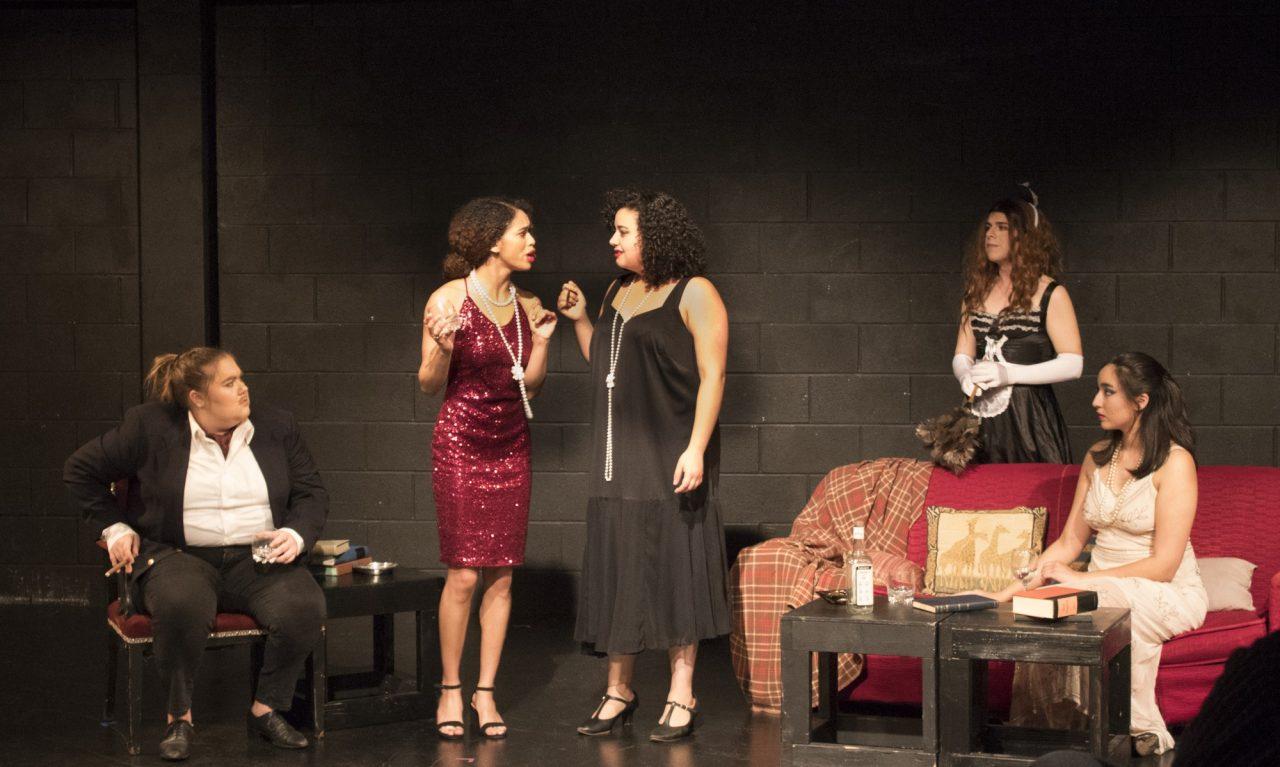Photo by Matthew Claybrook
“Vampire Lesbians of Sodom,” a theatre lab show directed by Sarah Bastos and based on a script written by Charles Busch in 1984, premiered in the Ruth Taylor Theatre Building attic on Thursday, Feb. 14 (performances ran from Thursday to Saturday, Feb. 16). While the title and premise — two immortal vampire lesbians who fight through the centuries, starting in biblical Sodom and ending in 1980s Las Vegas — seems more horror-genre than a typical Valentine’s Day theatre piece, the play feels surprisingly sweet, a love letter to monster mythos, old Hollywood and the power of vampire lesbians.
Buddy Buddy, Trinity University’s long-form improvisational comedy troupe, started off the show with a series of audience-led comedy games, including an extended skit that started with the word “ostrich” and ended up including someone trying to steal her sister’s hair; another skit was about the devaluation of subterranean currency — farewell, sand dollar — which was, of course, stopped by the President of China depriving the rich of their Lamborghinis (don’t think about it too hard); and a game called “Sex with me is like…” that I mainly remember for “Sex with me is like a business major: you go for it after you’ve tried everything else.” Overall, the atmosphere of this opening act — which contained several Vampire Lesbians actors — was fun, and everyone was excited for the actual show to begin.
Vampire Lesbians of Sodom is first and foremost about the the rivalry of two female vampires: La Condesa (or the Succubus), played by sophomore Aria Gaston-Panthaki, an ancient and more than slightly melodramatic vampire, and Madeline Astarte, played by sophomore Sophia Elsadig, a younger vampire who was originally bitten by La Condesa as a virgin sacrifice in biblical Sodom. Astarte survived the attack, became a vampire herself and followed La Condesa through time and space to get revenge. Over the course of the show, they meet 1920s movie stars King Carlisle, played by first year Gigi Herman, and Renee Vain, played by sophomore Judit Casanova, a male vampire hunter disguised as a gossip columnist named Oatsie, played by junior Mac Holt, as well as other amusing characters.
I was impressed by the consistent humor of the show and the surprisingly moving ending. However, what was most interesting to me was the relationship between the two main characters, or “lesbian vampires,” and how they changed over time. Madeleine’s character arc as a traumatized, naive young “virgin” who grows up and gains power was very well-done, and La Condesa was believable within the realm of this outrageous and campy performance as an older and world-weary — but still very dramatic and theatrical — vampire. The depiction of two female characters as well-rounded rivals is something that we don’t get a lot in media, while male rivals is a common fictional trope — so the undead Xavier vs. Magneto dynamic was refreshing. As Sarah Bastos points out in the show’s director note, it’s amazing that a man wrote a play about lesbians in the 1980s that does well with its characters for the most part.
While the over-the-top sensibility of this show is reminiscent of “The Rocky Horror Picture Show,” I prefer “Lesbian Vampires” because while critics have pushed back against “Rocky Horror” recently due to its transmisogynistic aspects, “Lesbian Vampires” has fun and well-rounded characters: while La Condesa and Madeleine are vampires, they’re not monsters, and the play avoids a lot of negative stereotypes surrounding queer characters in horror. In addition, while there were drag elements in “Lesbian Vampires,” I thought they were relatively non-offensive and fun.
“The play has its issues, most of which were adapted to be as inclusive as possible,” Bastos wrote in her director’s note. “My overall goal was to celebrate the LGBTQIA+ community through comedy and camp, but also by introducing you to these two powerful, cunning and beautiful lesbian women. These women — although bloodsucking vampires — are the epitome of all the amazing queer women I know. … And this Valentine’s Day, I hope you also take a close look at the women in your life and see the incredible inner lesbian vampire in all of them.”







